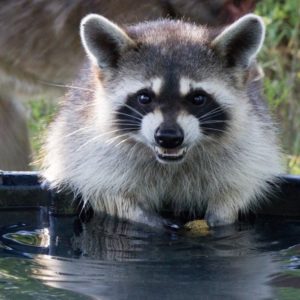Our sanctuary in south Texas offers a home for life to more than 200 monkeys. But, alongside the monkeys, our 175-acre site is also home to a host of other native wildlife species, including skunks, opossums, snakes, feral pigs, and raccoons.
Raccoons Are Highly Adaptable and Widely Distributed
Raccoons are one of the most widely distributed mammals in North America and are found across Canada, the United States, Mexico, and even in northerly regions of South America. They are masters of adaptation and have learned to live in many different environments, from the most isolated rural locales to densely occupied urban areas. These highly intelligent problem solvers are often considered “pests” precisely because they are so adept at using human-made environments to serve their needs. Whether it is rifling through trash to find food or making homes in our houses, raccoons may be cute, but they are not always welcome.
How Born Free USA Manages Raccoons at Our Primate Sanctuary
Born Free believes in living peacefully alongside all animals, and our sanctuary team leads by example. We take measures to humanely manage raccoon populations by following our principles of coexistence:
Some Raccoon Appreciation
By following these simple guidelines, our sanctuary team and the monkeys have the privilege of witnessing the antics of our raccoon friends, while ensuring that everyone stays safe, and problems are mitigated. Here are a handful of photos of just some of the beautiful “trash pandas” we share our sanctuary with…
Keep Wildlife in the Wild,
Liz
Dear Reader,
We are a nonprofit committed to wildlife conservation, welfare, and rescue. Making resources free and widely distributed, like our news items, is an important part of our mission. If you found this article helpful, enjoyable, or enlightening, please donate to help keep these resources available, and Keep Wildlife In The Wild.
Thank You,
The Born Free USA Team





 Dear Reader,
Dear Reader,